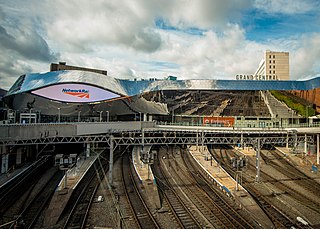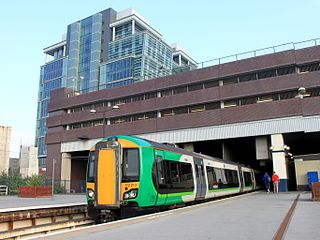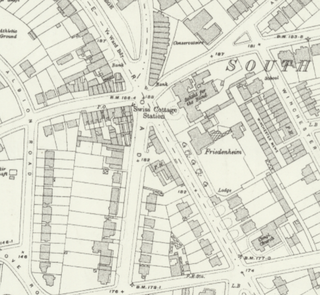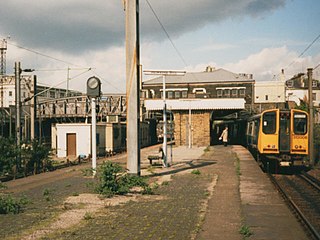
Blackheath railway station is Grade II-listed and is in the south-centre of Blackheath, a village in southeast London. In traditional terms the area immediately south-west of the station around Lee Terrace and Lee Park is part of Lee; a status challenged by the station's naming, buildings such as the Blackheath Halls and the development of Blackheath Park to the south east. It is 8 miles 52 chains (13.9 km) measured from London Victoria.

Birmingham New Street, also known as New Street station, is the largest and busiest of the three main railway stations in Birmingham city centre, England, and a central hub of the British railway system. It is a major destination for Avanti West Coast services from London Euston, Preston, Glasgow Central and Edinburgh Waverley and West Midlands Trains services from Liverpool Lime Street and London Euston both via the West Coast Main Line. The CrossCountry network centres on New Street, as well as local and suburban services within the West Midlands; these include those on the Cross-City Line between Lichfield Trent Valley, Redditch and Bromsgrove, and the Chase Line to Walsall and Rugeley Trent Valley. The three-letter station code is BHM.

Birmingham Snow Hill, also known as Snow Hill station, is a railway station in Birmingham City Centre. It is one of the three main city-centre stations in Birmingham, along with Birmingham New Street and Birmingham Moor Street.

Baker Street is a London Underground station at the junction of Baker Street and the Marylebone Road in the City of Westminster. It is one of the original stations of the Metropolitan Railway (MR), the world's first underground railway, opened on 10 January 1863.

Rugby railway station serves the market town of Rugby in Warwickshire, England. The current station dates from 1885; two previous stations dating from 1838 and 1840 respectively, existed at locations to the west of the current one. It has been Rugby's only station, since the closure of the former Rugby Central station in 1969, on the now-abandoned Great Central Main Line route through the town. Between 1950 and 1970, the station was known as Rugby Midland before reverting to its original title. The station underwent an extensive remodelling between 2006 and 2008; new platforms were added and a new ticket office and entrance building were constructed. The original Victorian part of the station was retained in the upgrade.

Brighton railway station is the southern terminus of the Brighton Main Line, the western terminus of the East Coastway Line and the eastern terminus of the West Coastway Line in England, and the principal station serving the city of Brighton, East Sussex. It is 50 miles 49 chains from London Bridge via Redhill. The station has six bus stops which are served by Brighton & Hove bus routes 1, 1A, N1, 5B, 6, 7, N7, 12, 12A, 12X, 13X, 14, 14C, 18, 24, 26, 27, 27B, 27C, 46, 48, 49, 55, 59 and 79.

Edge Hill railway station is a railway station that serves the district of Edge Hill, Liverpool, England and is one of the oldest railway stations in the world.

Swiss Cottage is a disused London Underground station in Swiss Cottage, north-west London. It was opened in 1868 as the northern terminus of the Metropolitan and St. John's Wood Railway (M&StJWR), the first northward branch extension from Baker Street of the Metropolitan Railway.

Primrose Hill was a railway station in Chalk Farm, in the London Borough of Camden, opened by the North London Railway as Hampstead Road in 1855. It was named Chalk Farm from 1862 until 1950, when it was given its final name. From the 1860s to 1915, it was linked with a formerly separate station opened by the London and North Western Railway in 1852. The station closed in 1992, and the platform buildings and canopies were removed in 2008.

The Cotswold Line is an 86+1⁄2-mile (139.2 km) railway line between Oxford and Hereford in England.

Aston railway station serves the districts of Aston and Nechells in Birmingham, England. The passenger entrance is on Lichfield Road. The station is on the Cross-City Line and the Chase Line. It is one of two local stations for Aston Villa Football Club and near to the Aston Expressway and to Gravelly Hill Interchange.

The Northampton loop is a railway line serving the town of Northampton. It is a branch of the West Coast Main Line, deviating from the faster direct main line which runs to the west. The WCML is a four track line up to either end of the Loop: the 'up' and 'down' fast tracks take the direct route while the 'up' and 'down' slow tracks are diverted via Northampton railway station. Generally, fast express trains run via the direct line, while freight and slower passenger services run via the loop line.

Birmingham Moor Street, also known as Moor Street station, is one of three main railway stations in the city centre of Birmingham, England, along with Birmingham New Street and Birmingham Snow Hill.

Wood End is a railway station on the North Warwickshire Line serving the village of Wood End in Warwickshire, England.
Somerset Road railway station was a railway station in Edgbaston, Birmingham, England, on the Midland Railway's Birmingham West Suburban Railway. The station had two platforms and was located in a cutting.
The Great Western and Great Central Joint Railway was a railway built and operated jointly by the Great Western Railway (GWR) and Great Central Railway (GCR) between Northolt and Ashendon Junction. It was laid out as a trunk route with gentle curves and gradients and spacious track layouts. The two companies each needed approach railways at both ends of the line to connect their respective systems; these were built as part of a single project.

Queensbury railway station was a station on the Queensbury lines serving the village of Queensbury, West Yorkshire, England. The station was unusual due to its triangular shape, and at its opening the only other examples of this arrangement were Ambergate station in Derbyshire and Earlestown in Lancashire; since then Shipley station, also in West Yorkshire, has gained platforms on all three sides. Of the stations on the Queensbury lines, this was the most ambitious.

Granville Street railway station was a railway station in Birmingham, England. It was the original terminus of the Midland Railway's Birmingham West Suburban Railway (BWSR).

Salehurst Halt was a halt station on the Kent and East Sussex Railway which served the village of Salehurst in East Sussex, England. The station was reached by a footpath leading south from the village church in Salehurst. Closed in 1954, Salehurst Halt may yet see trains again as the Rother Valley Railway, a preservation society, is proposing to reopen the line from Robertsbridge to Bodiam, including the line through the halt.

The Reading–Taunton line is a major branch of the Great Western Main Line from which it diverges at Reading railway station. It runs to Cogload Junction where it joins the Bristol to Exeter and Penzance line.



















